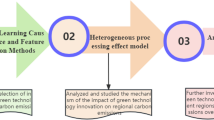Abstract
This paper investigates the relationship between green technology innovation and energy intensity for 29 provinces in Mainland China from 1999 to 2010. Based on changes in energy intensity in the data, the provinces are divided into four groups: the conventional group, the gradational group, the contemporary group, and the low-carbon group. Industrial structure is included in the study because of its impact on energy intensity, thus avoiding the problem of omitted variable bias. The empirical results indicate that there is a negative, long-run, cointegrated relationship between energy intensity and green technology innovation. We also discover unidirectional causality from green technology innovation to energy intensity in the conventional and low-carbon groups, whereas green technology innovation directly affects energy intensity through a feedback system for the gradational and contemporary groups. To achieve the goal of energy intensity, policymakers should encourage green technology diffusion from the low-carbon group to the conventional group and improve the share of green technology innovation in the gradational and contemporary groups.



Similar content being viewed by others
References
Acemoglu D, Aghion P, Bursztyn L, Hemous D (2012) The environment and directed technical change. Am Econ Rev 102(1):131–166
Aghion P, Dechezlepretre A, Hemous D et al (2014) Carbon taxes, path dependency and directed technical change: Evidence from the auto industry. J Political Econ (forthcoming)
Asafu-Adjaye J (2000) The relationship between energy consumption, energy prices and economic growth: time series evidence from Asian developing countries. Energy Econ 22:615–625
Elena V, Marzio G (2011) At home and abroad: an empirical analysis of innovation and diffusion in energy technologies. J Environ Econ Manag 61:119–134
Fan Y, Liu LC, Wu G, Wei YM (2007) Changes in carbon intensity in China: empirical findings from 1980–2003. Ecol Econ 62:683–691
Feng T, Sun L, He Z (2008) An empirical study of technology progress moderating effect on energy intensity in China. Stud Sci Sci 23(1):1–6
Feng D, Long R, Zhou D et al (2012) The relationship between industrial structure, technical progress, and opening degree with unit GDP energy consumption approach. Chin J Manag 9(4):603–610
Fisher-Vanden K, Jefferson GH (2008) Technology diversity and development: evidence from China’s industrial enterprises. J Comp Econ 36(4):658–672
Garbccio RF et al (1999) Why has the energy output ratio fallen in China? J Energy 20(3):73–82
Hang and Tu (2007) The impacts of energy prices on energy intensity: evidence from China. Energy Policy 35:2978–2988
Hart R (2004) Growth, environment and innovation—a model with production vintages and environmentally oriented research. J Environ Econ Manag 48:1078–1098
Jin L et al (2011) Energy consumption per GDP in various regions of China and its mode. Energy Procedia 5:2335–2339
Kao C, Chiang MH (2000) On the estimation and inference of a cointegrated regression in panel data. In: Baltagi BH (ed) Nonstationary panels, panel cointegration, and dynamic panels. Elsevier, Amsterdam
Lun R (2010) Mechanism analysis and empirical study on inter-industry spillovers of energy saving techniques. Stud Sci Sci 28:865–871 (In Chinese)
Ma C, Stern DI (2008) China’s changing energy intensity trend: a decomposition analysis. Energy Econ 30(3):1037–1053
Masih AMM, Masih R (1997) On the temporal causal relationship between energy consumption, real income and prices: some new evidence from Asian-energy dependent NICs based on a multivariate cointegration/vector error-correction approach. J Policy Model 19(4):417–440
OECD (2011a) Patent search strategies for the identification of selected environment-related technologies. http://www.oecd.org/environment/innovation. Accessed 25 March 2012
OECD (2011b) Invention and transfer of environmental technologies. OECD Studies on Environmental Innovation, OECD Publishing, Paris
Pedroni P (1999) Critical values for cointegration tests in heterogeneous panels with multiple regressors. Oxford Bull Econ Stat 61(4):653–670
Phillips PCB, Moon HR (1999) Linear regression limit theory for nonstationary panel data. Econometrica 67:1057–1111
Popp D (2006) International innovation and diffusion of air pollution control technologies: the effects of NOX and SO2 regulation in the US, Japan, and Germany. J Environ Econ Manag 51(1):46–71
SIPO (2013) State Intellectual Property Office of the People’s Republic of China website. http://www.sipo.gov.cn/. Accessed 25 May 2013
Smulders S, Bretschger L, Egli H (2011) Economic growth and the diffusion of clean technologies: explaining environmental Kuznets curves. Environ Resource Econ 49:79–99
Vanessa O, Maider SJ (2005) The dynamics of environmental innovations: three stylised trajectories of clean technology. Econ Innov New Technol 14(3):189–212
Wang B (2010) Can CDM bring technology transfer to China?-An empirical study of technology transfer in China’s CDM projects. Energy Policy 38(5):2572–2585
Xu B, Chiang E (2005) Trade, patents and international technology diffusion. J Int Trade Econ Dev Taylor & Francis J 14(1):115–135
Yang F (1993) Enterprise green technology innovation process and pattern. Zhejiang University, Hangzhou (In Chinese)
Zeng S, Chen Q (2009) The comparative study of the influence of economic growth on environmental quality in eastern China and the central China and the western China. Stat Decision 278:113–115 (In Chinese)
Acknowledgments
This paper was supported by the National Nature Science Foundation of China (Grant No. 70973011), the China Postdoctoral Foundation (Grant No. 2014M560882), and the social science research project of Hebei Province (Grant No. HB14YJ018). This work could not have been completed without the support of the Engineering Construction Management Key Research Institute of Humanities and Social Science of the Hebei Education Department.
Author information
Authors and Affiliations
Corresponding author
Rights and permissions
About this article
Cite this article
Chen, Y., Han, B. & Liu, W. Green technology innovation and energy intensity in China. Nat Hazards 84 (Suppl 1), 317–332 (2016). https://doi.org/10.1007/s11069-016-2158-7
Received:
Accepted:
Published:
Issue Date:
DOI: https://doi.org/10.1007/s11069-016-2158-7




